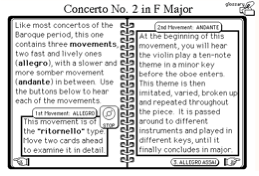
Tim Oren writes a nice little Eulogy for HyperCard.
A few things stick out in my mind about Hypercard.
It was incredibly fast. Software today rarely seems as fast. It could do a page turn faster than my G4 seems to be able to type a single character. It did could do these sweet builds from one page to the next that continue to this day in presentation software. You never saved data. That reminded me of APL workspaces.
It was one of the first applications to take seriously the idea that behavior might be inherited not in via the type/subtype hierarchy but via the document enclosure topology. So a button that when a button invoked the function F hypercard would search for the implementation of F first in the button, then the page, then document.
Tim points out that Hypercard wasn’t broken into client and server as we would likely do today. More important to me at the time and still today was that there was nothing you could do in the UI that you couldn’t do in the scripting language. That made it possible to do all kinds of very sweet animation on top of the amazing painting engine. This design pattern of a strong deep data type with a scripting engine laid over it is very powerful. You see it in Autocad, Emacs, and Excel. A lot of software these days the only deep data structure is – tada: the database. That gets dull pretty quickly.
When the Mac first came over the wall in 1984 I was fascinated by how it empowered a huge population of people to use computers. For the first time you really could bring one home and get to work writing that novel. A lot of people complained that the machine wasn’t friendly to programmers, which struck me as totally missing the point.
So I got curious about how you might empower a large population of people to program. Could you create the same event over again, this time enabling people to write software. The only example of even coming close at that point was the spreadsheet.
Hypercard did exactly that. It never competed with the installed base of developers. Instead it generated this amazing bloom of new tiny little applications. Instead it illustrated what happens when you manage to hand a useful tool over to a large unserved population of amateurs. The tail of the power-law curve.
I wonder, if flash is the closest modern equivalent; maybe so.

